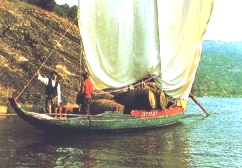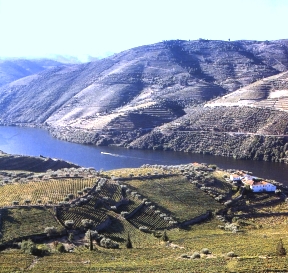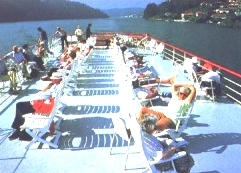|
|
|
|
WORLD HERITAGE SITES OF PORTUGAL
UPPER DOURO
ALTO DOURO
Wine has been produced by traditional landholders in the Alto Douro region for some 2,000 years. Since the 18th century, its main product, port wine, has been world famous for its quality. This long tradition of viticulture has produced a cultural landscape of outstanding beauty that reflects its technological, social and economic evolution. 
The result of this human activity has modified the landscape by incorporating terraces, quintas (wine producing farm complexes), villages, chapels, and roads and railways.The cultural landscape of the Alto Douro is an outstanding example of a traditional European wine producing region and for this it has been granted World Heritage Site Status.
The river Douro rises in Spain and the traditional 'Rabelo' boats were used to get the wine down the fast flowing river to the western coast and the markets of the world.
In the 19th century this perilous journey was replaced by railway when the track was driven along the bank of the river and its tributaries.
Nowadays road tankers are used however the roads in the wine growing region, with their overhanging houses, were not designed for vehicles of this size.

In recent years to control flooding downstream and also to produce electricity, the river has been tamed by a series of dams resulting in a series of placid lakes.The dams have locks in them and it is now possible to travel the breadth of Portugal from the Spanish border to the sea at Porto by boat.
The hotel boats taking tourists on a weeks cruise through this wonderful scenery are one of the main users of the river nowadays.
Opportunity should be taken to visit some of the places a short distance from the river. One of the best is Lamego where a medieval cathedral stands in the centre of the town. This fortress-church features a bell tower and a 16th century triple portico on the facade. Inside the design work of the ceilings is by Nicole Nissan. See the chancel, the chapel of Sacramento, the choir, the organs and the elegantly arched cloister.
Another building of note is the Museum which has some exceptional 15th century paintings, a splendid collection of Flemish tapestries and also religious art. Visits should be made to the Romanesque Igreja de Santa Maria de Almacave, the Remedios Fountain and various manor houses. On a hill overlooking the town is the shrine of Nossa Senhora dos Remedies which is approached by a magnificent stairway.

To the north is the Archeological Park of Vale of Cao with its prehistoric rock carving which is itself a UNESCO World Heritage Site.The region has a hot dry micro climate and rocky soil from the 'shist' sedimentary rock of the area. This results in ideal growing conditions for grapes and the banks of the river have the steeply terraced vineyards of the white painted vineyards.
The small villages have strong local cultures based on religious festivals together with regional crafts of basket work, pottery and the work of tinsmiths. The local gastronomy includes regional bread baked in wood ovens eaten with smoked ham or sausage.
Beside the colours of the vineyards, the are is famous for the beauty of the blossom of the fruit trees which is particularly striking in February. The almond trees are the most striking but fruits also include apples, pears, cherries, oranges and figs.
For a selection of accommodation in the area please visit the Regua page.
Text provided by the Portuguese Tourist Office